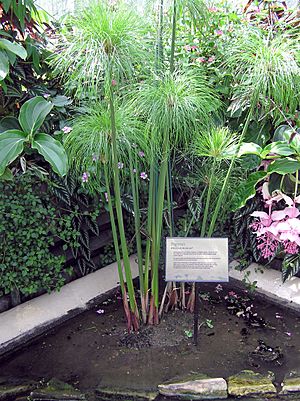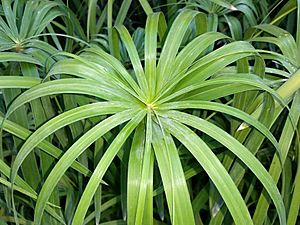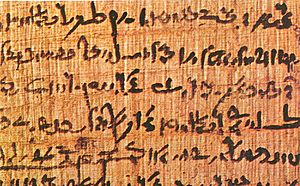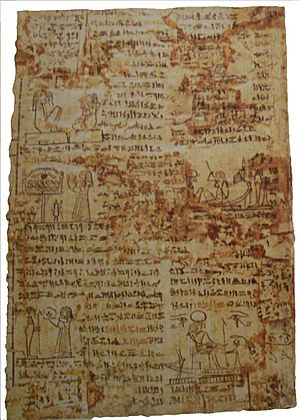Paper reed facts for kids
Quick facts for kids Papyrus Sedge |
|
|---|---|
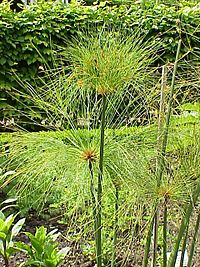 |
|
| Scientific classification | |
| Kingdom: | |
| Division: | |
| Class: | |
| Order: | |
| Family: | |
| Genus: |
Cyperus
|
| Species: |
C. papyrus
|
| Binomial name | |
| Cyperus papyrus L.
|
|
Cyperus papyrus (also called papyrus sedge, paper reed, or Nile grass) is a type of aquatic plant that flowers. It belongs to the sedge family, called Cyperaceae. This plant is a soft, green plant that lives for many years. It grows naturally in Africa. It forms tall groups of plants that look like reeds in shallow water.
People have used papyrus sedge for a very long time. The Ancient Egyptians especially used it. It is the plant from which papyrus paper was made. This was one of the very first types of paper ever created! You can also eat parts of the plant. Its stems float very well, so they can even be made into boats. Today, people often grow papyrus sedge as a plant just for decoration.
In nature, papyrus sedge grows in sunny, flooded swamps. It also grows along the edges of lakes across Africa, Madagascar, and countries near the Mediterranean Sea.
The C. papyrus plant and a smaller version called C. papyrus 'Nanus' have both won an award. This award is called the Royal Horticultural Society's Award of Garden Merit.
Contents
What Papyrus Sedge Looks Like
This plant is tall and strong. It is an aquatic plant, meaning it grows in water. It can reach a height of 4 to 5 meters (about 13 to 16 feet). It grows in a clump, like grass. Its green stems are shaped like triangles. These stems grow up from thick, woody roots called rhizomes.
Each stem has a thick bunch of thin, bright green, thread-like stems at its top. These are about 10 to 30 centimeters (4 to 12 inches) long. When the plant is young, this top part looks like a feather duster. Later, greenish-brown flower clusters appear at the ends of these threads. These flowers then turn into small, brown, nut-like fruits.
Papyrus in Ancient History
The Egyptians called this plant aaru. They used it for many things. The most famous use was making papyrus paper. The name "papyrus" in Greek and English likely came from the Egyptian name. Today, Cyperus papyrus is mostly grown for decoration. It is almost extinct in its natural home in the Nile Delta. In ancient times, it was grown widely there.
Other plants in the Cyperus family might also have been used by Egyptians. The plant's flowering tops were made into garlands. These were like wreaths for their gods. The soft inside part of young shoots could be eaten. People ate it both cooked and raw. The tough, woody root was used to make bowls and other tools. It was also burned for fuel.
The stems were used to make reed boats. Pictures from ancient times show people cutting papyrus to build boats. Similar boats are still made in southern Sudan today. The stems were also used for sails, mats, cloth, ropes, and sandals. The "reed" basket in which the Biblical figure Moses was found might have been made from papyrus.
Where Papyrus Sedge Grows (Ecology)
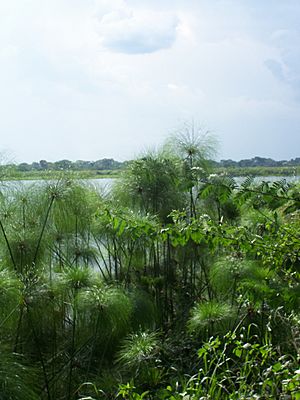
Papyrus can be found in tropical rainforests. It can handle temperatures between 20 to 30°C (68 to 86°F). It also grows in soil with a pH from 6.0 to 8.5. Papyrus flowers in late summer. It prefers full sun but can grow in partly shady places. Like most tropical plants, it is sensitive to frost and cold weather. In the United States, it has spread in Florida. It has also escaped from gardens in Louisiana, California, and Hawaii.
Papyrus sedge forms huge groups in swamps. It also grows in shallow lakes and along stream banks. You can find it throughout the wetter parts of Africa. However, it has become rare in the Nile Delta. In deeper water, it forms large, floating mats of tangled plants. These mats are known as sudd. Papyrus also grows in Madagascar and some areas around the Mediterranean Sea, like Sicily and the Levant.
The "feather-duster" tops of the plant are perfect places for many kinds of birds to build their nests. Like most sedges, papyrus is pollinated by wind, not insects. When the fruits are ready, they are spread by water.
How to Grow Papyrus Sedge (Cultivation)
It is quite easy to grow the papyrus plant from seeds. However, in Egypt, it is more common to split the plant's roots. Once it starts growing, it grows quite fast.
To plant seeds, place them close to the surface. Use moist planting soil mixed with peat and sand. A good mix is two parts soil, one part peat, and one part sand. Keep the soil moist and at a temperature of 25 to 28°C (77 to 82°F). The seeds should sprout in 25 to 30 days. Once they have grown, keep the soil very wet all the time. Also, place the plants in a sunny spot.
Many Uses of Papyrus
In Ancient Egypt, papyrus was used for many different things. These included baskets, sandals, blankets, and even medicine. It was also used as incense and to build boats. The woody root was used to make bowls and other tools. It was also burned for fuel. Egyptians used every part of the plant efficiently. Papyrus was an important "gift of the Nile." Its uses are still remembered and celebrated in Egyptian culture today.
See also
 In Spanish: Cyperus papyrus para niños
In Spanish: Cyperus papyrus para niños


